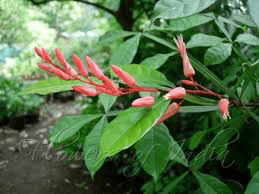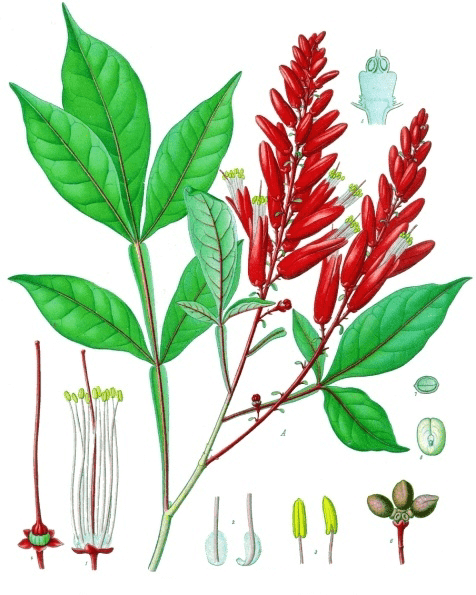Amargo, scientifically known as Quassia amara, is a remarkable medicinal plant with a rich history of traditional use and a host of health benefits.
The history of Amargo as a medicinal plant is deeply rooted in indigenous cultures of Central and South America, where it was revered for its therapeutic properties. Indigenous peoples recognized the plant’s bitterness as a sign of its medicinal potency and began using it for various ailments.
European explorers and settlers learned about Amargo from indigenous communities and brought this valuable medicinal plant back to Europe. It gained popularity in traditional European herbal medicine, where it became known for its digestive and tonic properties.
The Botanical Description of Amargo
1. Life: Amargo is an evergreen tree or shrub that belongs to the family Simaroubaceae. It has a perennial life cycle and can thrive for many years.
2. Leaves: The leaves of Amargo are compound, pinnate, and alternately arranged. They are dark green, glossy, and exude a strong, bitter aroma when crushed.
3. Flowers: Amargo produces small, greenish-yellow flowers that are typically unisexual, with male and female flowers occurring on separate plants.
4. Fruits: The fruit of Amargo is a small, woody capsule that contains winged seeds. These seeds are often dispersed by wind, allowing the plant to propagate.
5. Bark: The bark of Amargo is the most sought-after part of the plant for its medicinal properties. It is grayish-brown and contains the bitter principles responsible for its health benefits.
6. Habitat: Amargo is native to tropical regions of Central and South America, thriving in rainforests and humid environments with well-drained soils.
The botanical description of Amargo reveals its unique characteristics, including its bitter leaves and bark, which are key to its medicinal use. Now, let’s explore the specific medicinal health benefits that Amargo offers to those who seek natural remedies.
The Geographic Distribution of Amargo
Amargo (Quassia amara) exhibits a distinct geographic distribution that aligns with its native habitats and regions where it is cultivated or naturally found. Here are five key points regarding its distribution:
1. Native to Tropical America: Amargo is native to the tropical regions of Central and South America, including countries such as Brazil, Colombia, Venezuela, and Guyana.
2. Rainforests: It thrives in lush rainforests and humid environments, where it can be found growing alongside diverse flora and fauna.
3. Naturalized in the Caribbean: Amargo has become naturalized in certain Caribbean islands, such as Jamaica and Puerto Rico, due to its historical use and potential for cultivation.
4. Cultivated in Other Regions: Beyond its native range, Amargo is cultivated in various regions worldwide, including parts of Asia, Africa, and Europe, where it is valued for its medicinal properties.
5. Adaptable to Different Soils: Amargo can adapt to a range of soil types, provided they are well-drained, making it a versatile plant for cultivation.
The Chemical Composition of Amargo
Amargo (Quassia amara) possesses a chemical composition that underpins its medicinal properties. Here are seven key components that constitute the chemical composition of Amargo:
1. Quassinoids: Quassinoids are the primary bioactive compounds in Amargo responsible for its bitterness and various health benefits.
2. Terpenoids: Amargo contains terpenoids, which contribute to its aromatic properties and potential therapeutic effects.
3. Alkaloids: Some alkaloids have been identified in Amargo, although their specific effects are still being studied.
4. Flavonoids: Flavonoids are present in Amargo and contribute to its antioxidant properties.
5. Triterpenes: Triterpenes are another group of compounds found in Amargo, which may have potential health benefits.
6. Essential Oils: The plant may contain essential oils that contribute to its aromatic properties.
7. Phenolic Compounds: Certain phenolic compounds have been identified in Amargo, which may contribute to its antioxidant and anti-inflammatory effects.
The Cultivation and Growth of Amargo
1. Climate Requirements: Amargo thrives in tropical climates with consistent warmth and high humidity. It is sensitive to frost and requires temperatures above freezing.
2. Soil Conditions: Well-drained, fertile soils with good moisture retention are ideal for Amargo cultivation.
3. Sunlight: It prefers partial to full sunlight, making it well-suited for rainforest understory growth.
4. Water Requirements: Amargo requires regular watering to maintain soil moisture levels, particularly during dry periods.
5. Propagation: Amargo can be propagated from seeds or by taking stem cuttings, with seeds being the more common method.
6. Growth Rate: Amargo is a slow-growing plant, and it may take several years to reach maturity.
7. Pruning: Pruning is typically done to shape the plant or remove dead or damaged branches.
8. Pest and Disease Management: While generally resilient, Amargo may be susceptible to certain pests and diseases, requiring appropriate management measures.
The Harvesting and Processing of Amargo
1. Harvesting Timing: The bark of Amargo, which contains the bitter quassinoids, is typically harvested from mature trees. This is done during the dry season when the bark is most potent.
2. Bark Collection: Careful attention is given to the collection of bark to avoid damaging the tree. Only a portion of the bark is harvested to ensure the plant’s continued health.
3. Drying: After harvesting, the bark is dried to reduce moisture content and preserve its medicinal properties.
4. Storage: Dried Amargo bark is stored in a cool, dry place to maintain its quality and potency.
5. Processing: The dried bark may be further processed, ground into a powder, or used in various herbal preparations.
6. Preparation Methods: Amargo bark can be used to make infusions, tinctures, or extracts for medicinal purposes.
Read Also: 13 Medicinal Health Benefits of Androstephium coeruleum (Blue Funnel Lily)
The Medicinal Health Benefits Of Amargo (Quassia amara)

Amargo (Quassia amara) offers a multitude of medicinal health benefits, harnessing its unique chemical composition. Here are 15 of its remarkable health benefits:
1. Digestive Aid: Amargo has a long history of use as a digestive tonic, helping to alleviate indigestion, stimulate appetite, and promote healthy digestion.
2. Appetite Stimulation: Its bitter compounds can stimulate the appetite, making it beneficial for individuals with reduced food intake.
3. Antioxidant Properties: Amargo contains flavonoids and other antioxidants that help combat free radicals, reducing oxidative stress.
4. Anti-Inflammatory Effects: It may have anti-inflammatory properties, potentially reducing inflammation-related conditions.
5. Liver Support: Amargo is used to support liver health, aiding in detoxification processes and promoting liver function.
6. Antiparasitic Properties: Amargo has been traditionally used as an antiparasitic remedy, particularly against intestinal parasites.
7. Antimicrobial Activity: Certain compounds in Amargo may exhibit antimicrobial properties, helping to combat various pathogens.
8. Fever Reduction: Amargo has been used to reduce fever in traditional medicine.
9. Anti-diabetic Effects: Some studies suggest that Amargo may have potential benefits for individuals with diabetes, helping to regulate blood sugar levels.
10. Gastrointestinal Health: It can alleviate various gastrointestinal issues, such as diarrhea and stomach cramps.
11. Weight Management: Amargo’s appetite-stimulating properties may be helpful for individuals struggling with weight loss or poor appetite.
12. Anticancer Potential: Preliminary research has explored Amargo’s potential anticancer properties, particularly in relation to certain types of cancer cells.
13. Immune System Support: The presence of antioxidants in Amargo can support the immune system and enhance resistance to infections.
14. Skin Health: Topical applications of Amargo may help soothe skin conditions, including itching and irritation.
15. Respiratory Health: Amargo has been used for respiratory issues, potentially alleviating coughs and bronchial conditions.
Methods of Usage to Achieve the Provided Health Benefits Of Amargo (Quassia amara)
To harness the health benefits of Amargo, various methods of usage can be employed:
1. Herbal Infusion: Prepare a herbal infusion by steeping dried Amargo bark in hot water. This can be consumed as a tea.
2. Tincture: Create a tincture using Amargo bark and alcohol. This concentrated liquid can be taken in small doses.
3. Capsules: Capsules containing Amargo extracts or powders are available as a convenient way to incorporate it into your routine.
4. Topical Applications: Amargo-infused oils or creams can be applied topically for skin conditions and wound healing.
5. Dietary Supplement: Add dried Amargo bark powder to your diet as a supplement.
6. Extracts: Liquid extracts of Amargo can be used for medicinal purposes, following recommended dosages.
7. Bitter Tonics: Amargo is often used as a bitter tonic before meals to stimulate digestion and appetite.
8. Traditional Recipes: Explore traditional recipes and remedies that incorporate Amargo for specific health concerns.
Side Effects Of Using Amargo Medicinal Plant
While generally considered safe, it’s important to be aware of potential side effects when using Amargo:
1. Excessive Bitterness: The extreme bitterness of Amargo may be unpleasant for some individuals.
2. Allergic Reactions: Allergic reactions to Amargo are rare but possible. Monitor for any signs of allergies.
3. Gastrointestinal Discomfort: Excessive consumption may lead to digestive discomfort or diarrhea.
4. Pregnancy and Breastfeeding: Pregnant and breastfeeding individuals should use Amargo with caution and consult with a healthcare provider.
5. Drug Interactions: Amargo may interact with certain medications, so consult with a healthcare provider if you are taking prescription drugs.
6. Liver Health: If you have liver conditions or concerns, consult with a healthcare provider before using Amargo.
7. Dosage: Stick to recommended dosages, and avoid excessive consumption to prevent potential side effects.
8. Skin Sensitivity: Some individuals may experience skin sensitivity or irritation when using Amargo topically. Perform a patch test first.
9. Anticoagulant Effect: If you have bleeding disorders or are on anticoagulant medications, use Amargo with caution due to its potential anticoagulant properties.
10. Children and Infants: Use Amargo for children only under the guidance of a pediatrician.
Read Also: 15 Medicinal Health Benefits Of Alpinia officinarum (Lesser Galangal)
Scientific Research and Studies of Amargo

Scientific research on Amargo is ongoing, with a focus on its medicinal properties. Here are eight areas of scientific research and studies involving Amargo:
1. Digestive Health: Studies have explored Amargo’s effects on digestion, including its impact on digestive enzymes.
2. Antioxidant Activity: Research has investigated Amargo’s antioxidant potential, assessing its ability to combat oxidative stress.
3. Antimicrobial Properties: Studies have examined Amargo’s antimicrobial activity, looking at its effectiveness against various pathogens.
4. Antidiabetic Effects: Research has explored Amargo’s potential benefits for individuals with diabetes, including its impact on blood sugar levels.
5. Immunomodulatory Effects: Some studies aim to understand how Amargo may modulate the immune system and enhance immunity.
6. Antiparasitic Properties: Investigations have assessed Amargo’s effectiveness as an antiparasitic agent against specific parasites.
7. Liver Protection: Research has explored Amargo’s role in protecting the liver and supporting detoxification processes.
8. Traditional Medicine Validation: Some studies aim to validate the traditional uses of Amargo
The Safety Precautions and Recommendations In Using Amargo Medicinal Plant
When utilizing Amargo (Quassia amara) for its medicinal properties, it is crucial to observe safety precautions and adhere to recommendations to ensure safe and effective usage. Here are seven precautions and recommendations:
1. Consult a Healthcare Provider: Before incorporating Amargo into your healthcare routine, especially if you have underlying health conditions, are pregnant, or are taking medications, consult with a healthcare provider for personalized guidance.
2. Dosage Guidance: Follow recommended dosages provided by healthcare professionals, herbalists, or product labels. Excessive consumption may lead to adverse effects.
3. Allergy Testing: Perform an allergy test before using Amargo, particularly if you have a history of plant allergies. Apply a small amount to your skin and monitor for any allergic reactions.
4. Pediatric Use: Use Amargo for children and infants only under the guidance of a pediatrician or healthcare provider.
5. Liver Conditions: If you have liver conditions or concerns, consult with a healthcare provider before using Amargo, as it may impact liver health.
6. Monitor for Side Effects: Pay close attention to any side effects or adverse reactions when using Amargo, and discontinue use if any unusual symptoms arise.
7. Quality Control: Source Amargo products from reputable suppliers or manufacturers to ensure purity and quality.
The Legal Status and Regulations In Using Amargo Medicinal Plant
The legal status and regulations concerning the use of Amargo (Quassia amara) as a medicinal plant can vary by region and application. Here are six considerations regarding its legal status and regulations:
1. Herbal Supplement Regulations: Products containing Amargo as an herbal supplement may be subject to regulations related to labeling, safety, and quality control in certain regions.
2. Traditional Medicine Practices: Amargo has historical use in traditional medicine, and local regulations may exist to ensure its safe practice.
3. Herbal Remedies: Regulations regarding the sale and use of Amargo as an herbal remedy may apply, especially in commercial settings.
4. Intellectual Property: Be aware of intellectual property rights when using research or products related to Amargo for commercial purposes.
5. Import and Export: If you intend to import or export Amargo products, ensure compliance with relevant regulations and restrictions.
6. Quality Assurance: Ensure that Amargo products meet quality and safety standards by sourcing from reputable suppliers and looking for certifications.
FAQs About Amargo Medicinal Plant
Here are 18 frequently asked questions (FAQs) about Amargo (Quassia amara) as a medicinal plant:
1. What are the primary health benefits of Amargo?
Amargo is known for its digestive, liver-supporting, and antiparasitic properties, among others.
2. Is Amargo safe for daily consumption?
Use Amargo in moderation and adhere to recommended dosages to prevent adverse effects.
3. Are there any known allergies to Amargo?
Allergic reactions to Amargo are rare but possible. Perform an allergy test before use.
4. Can Amargo be used during pregnancy?
Pregnant individuals should consult with a healthcare provider before using Amargo.
5. Is Amargo suitable for breastfeeding mothers?
Consult with a healthcare provider before using Amargo while breastfeeding.
6. Can Amargo be used for children?
Use Amargo for children and infants only under the guidance of a pediatrician.
7. Are there potential drug interactions with Amargo?
Consult with a healthcare provider if you are taking medications to check for potential interactions.
8. How can Amargo be incorporated into a daily diet?
Consider using it as a herbal infusion or in supplement form, following recommended dosages.
9. Can Amargo help with weight management?
Some individuals use Amargo to stimulate appetite, potentially aiding in weight management.
10. Is Amargo effective for skin conditions?
Topical applications of Amargo may help with skin conditions, but consult with a dermatologist for guidance.
11. Can Amargo be used for respiratory issues?
Consult with a healthcare provider for respiratory issues, as Amargo alone may not replace medical treatment.
12. Is Amargo safe for individuals with liver conditions?
Use Amargo with caution and consult with a healthcare provider if you have liver conditions.
13. What are the potential side effects of Amargo?
Side effects may include excessive bitterness, allergies, gastrointestinal discomfort, and more. Monitor for any unusual symptoms.
14. Can Amargo be used as an immune booster?
Some individuals use Amargo for immune support, but it should not replace medical advice for immune-related conditions.
15. Is Amargo safe for individuals with bleeding disorders?
Use Amargo with caution if you have bleeding disorders due to its potential anticoagulant properties.
16. Can I grow Amargo in my garden?
If you live in a suitable climate, you may consider cultivating Amargo, but be aware of local regulations and environmental considerations.
17. Are there any contraindications for Amargo use?
Individuals with specific health conditions or concerns should consult with a healthcare provider before using Amargo.
18. What is the traditional use of Amargo in indigenous cultures?
Indigenous peoples traditionally used Amargo for its digestive and medicinal properties, recognizing its bitterness as a sign of potency.
Read Also: Cod Liver Oil Capsules: All You Need to Know About
